Abstract
Decarbonization and idle cropland reclaiming pose critical policy challenges. Agrivoltaic systems (AVSs), which merge agriculture and photovoltaics, offer a promising solution by reducing land use conflicts between agriculture and energy production. This study develops a GIS-based methodology to identify reclaimable idle croplands and assess the AVS’s contribution to agriculture and photovoltaic energy in Japan’s Kansai region. Using official geographic data and excluding high-risk areas, this study employs GIS for quantitative analysis. Our method detected more reclaimable idle cropland than previous studies. Focusing on food security while limiting AVS installations to reclaimable idle croplands could still generate up to 4564.08 GWh of electricity (0.8% of regional consumption) and 930.82 tons of soybeans (6.2% of regional yield). Under a more stringent scenario that excludes areas less suitable for solar power, 5 of 227 municipalities could achieve 15% electricity self-sufficiency through AVS. This research uncovers the existence of reclaimable idle croplands that could not be detected by existing methods and a decentralized power source available alongside food security maintenance. These insights will inform decarbonization and agricultural policy and guide the development of supportive and regulatory AVS frameworks.
1. Introduction
Climate change issues are driving the need for decarbonization in various sectors. Decarbonizing the agricultural sector is urgent, as approximately 30% of global greenhouse gas emissions come from agriculture [1]. In May 2021, the Japanese government launched its Strategy for Sustainable Food Systems, “MIDORI”. The strategy includes ambitious plans, such as “zero CO2 emission from fossil fuel combustion in agriculture, forestry and fisheries sectors”, a “30% reduction in chemical fertilizer use”, “electrification and hydrogen battery use for agricultural and forestry machinery as well as fishing vessels”, and the “introduction of renewable energy to Japan’s farming and fishing villages” as targets for the year 2050 [2]. Given its cost-competitive advantage and short lead time, photovoltaic technology is anticipated to play a pivotal role in this transition [3]. Following the enactment of the “Act on Special Measures Concerning the Procurement of Electricity from Renewable Energy Sources by Electricity Utilities” in August 2011, solar power has constituted 8.3% of Japan’s total electricity generation by FY2021 [4]. With targets set to elevate solar power’s contribution to 14–16% of the energy mix by 2030, an escalation in solar power generation is imperative. However, it has been pointed out that approximately two-thirds of Japan’s land area is covered with forests, and there are many steep slopes, which limits the land available for developing ground-mounted solar power plants [3].
In addition, Japanese agriculture faces the problem of idle cropland. The definition of idle cropland in this study is “cropland that is not actually used for cultivation and is not expected to continue to be used for cultivation”. This is an adaptation of the definition under the Cropland Law, which can be classified as reclaimable or not reclaimable depending on the circumstances of the devastation [5]. In Japan, the amount of planted farmland continues to decline due to a lack of labor and feeding damage by wild birds and beasts [6]. In Japan, where the food self-sufficiency rate in terms of production value is only 58%, the expansion of unused farmland and the stagnation of agricultural production and self-sufficiency are serious concerns for food security [7]. Abandoning farmland also poses the risk of loss of biodiversity by reducing the environmental mosaic and attracting damage by wild animals [8,9,10]. In the context of enhancing land utilization efficiency and advancing decarbonization, the conversion of land to ground-based solar power installations is one of the effective ways to fulfill these objectives. In fact, among instances where agricultural land has undergone transformation, approximately 10% has been repurposed for ground-based solar energy facilities [11,12]. However, as previously highlighted, the conversion of farmland into solar energy installations compromises food security, given the low self-sufficiency rate. Moreover, from a legal perspective, the establishment of photovoltaic systems on lands safeguarded by the Cropland Law is prohibited [5]. Although exemptions to this regulation are necessary for the installation of photovoltaic systems, the exemption procedure presents substantial challenges [13].
As a tool to address these issues, the agrivoltaic system (AVS), an initiative to simultaneously implement agricultural production and solar power generation on the same land, has attracted much attention [14,15]. The concept was first proposed in 1982 by Goetzberger and Zastrow of the Fraunhofer Institute for Solar Energy Systems in Germany [16]. With the AVS, farmers can obtain electricity derived from nonfossil fuels, benefit from increased revenues from the sale of electricity, and reduce their own consumption expenses. The AVS also encourages farmers and agricultural corporations to rehabilitate farmland that has been abandoned due to labor shortages or unfavorable farming conditions by making it more profitable.
In Japan, the Ministry of Agriculture, Forestry and Fisheries (MAFF) launched the AVS support scheme in 2013, which grants exceptions to the Cropland Act’s agricultural land protection regulations under certain conditions, allowing the installation of power generation facilities. The “MIDORI” strategy and the 6th Strategic Energy Plan also indicate a policy of using AVS, the appropriate use of which has become an important policy agenda item [3]. As of March 2022, there were 4349 approved AVS installations [17].
However, in some cases where AVSs have been installed, they have not fully taken advantage of their benefits. For example, in Japan, there are more than 100 cases in which agricultural production affected by AVSs has fallen below 20% of the regional average [18]. Previous studies have pointed to an inappropriate balance between power generation and agriculture as one factor causing these problems [19]. In particular, the overprioritization of solar power projects has led to “pseudo-farming”, in which excessive solar panel installations interfere with agricultural activities, and agriculture has become a nominal activity. To avoid the risk to food security posed by these problems, it is important to design appropriate institutions, such as those that use idle cropland.
Nevertheless, there is currently a lack of academic research contributing to policymaking and institutional design, especially research on the feasibility of AVS installations. Investigations, such as those by Sacchelli et al. [20], analyze the trade-offs between agricultural production and electricity generation, albeit within the Italian context. Similarly, the work by Katkar et al. [21] provides an evaluation of these dynamics in New York State, US, using the GIS-MCDA technique. However, there are few studies in Japan. Within the Japanese purview, studies by Takashima et al. [22] and Shimazaki [23] have explored the potential for photovoltaic systems on idle cropland, yet they did not encompass AVS. Meanwhile, the research by Muroki et al. [24] and Yamada et al. [25] have considered AVS installations but have not adequately engaged with the verification processes necessary to assess idle cropland, thus casting food security into question. Furthermore, research by Nakata et al. [26] and Sato et al. [27] used land use mesh data from the Japanese Ministry of Land, Infrastructure, Transport and Tourism (MLIT) at an approximate resolution of 100 m to identify idle cropland. Given the smaller scale of Japanese agricultural operations, this approach raises concerns regarding data precision [28]. As for public assessments, the Renewable Energy Feasibility Study has been implemented by Japan’s Ministry of the Environment (MOE) since 2009. The AVS was added to the scope of this survey in 2019, but the latest survey (2021) is based on prefecture-level statistics for examining idle cropland, which does not achieve the necessary accuracy [29]. Detailed and accurate install potential assessment is also essential for designing support policies such as subsidies and tax incentives.
Thus, the purpose of this study is to devise a highly precise methodology for the identification of reclaimable idle croplands. Furthermore, with the presumption that such identified reclaimable idle croplands will be revitalized through the installation of AVS, the detection methodology has been applied to the Kansai region of Japan to quantitatively ascertain the potential yield of agricultural products and the generation of electricity. The results are expected to provide policymakers with detailed insights into the distribution of reclaimable idle cropland, insights that remain undisclosed by existing government statistics and prior research, and to contribute to a balanced institutional design and efficient policy formulation.
2. Materials and Methods
2.1. Study Area
The geographical focus of this research is the Kansai region of Japan. Located in the southern-central part of the country, the region comprises 7 prefectures and spans 227 municipalities. As of 2020, its population was 22,311,695, and its area was 33,125.70 km2 [30]. The Kansai region is home to Japan’s second-largest industrial zone, the Hanshin Industrial Region, dominated by manufacturing [31]. Figure 1 presents the global horizontal irradiance in the Kansai region, equivalent to typical solar radiation levels observed across Japan [32].
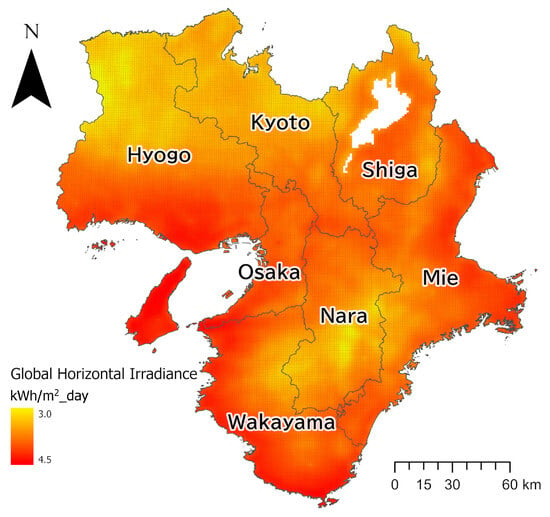
Figure 1.
Map of global horizontal irradiance in the Kansai Region. (Source: mapped from [32]).
2.2. Agrivoltaic System Design
The system configuration was established as follows to quantitatively evaluate the feasibility of introducing the AVS. The land area occupation ratio (LAOR) for AVS introduction is capped at 35%. The LAOR represents the ratio between the area covered by solar modules and the total land area used [33]. An LAOR of 35% is considered nonintrusive to the agricultural production of numerous crop species in Japan [34]. The system architecture incorporates an open-field, fixed overhead PV system, known as the rattan-shelf type AVS, which is widely implemented in Japan. The levelized cost of electricity (LCOE) for AVS within this design is projected to be approximately JPY 26.58/kWh (20.47 Euro cents) for installations with a capacity of 50 kWac, representing the typical scale for AVSs in Japan. Under the feed-in tariff system effective as of 2024, the buying price for electricity generated at this magnitude has been established at JPY 10.1/kWh, inclusive of tax. This pricing structure suggests challenges in achieving profitability under the current conditions. Nonetheless, when the electricity generated is either consumed onsite or marketed via the feed-in premium (FIP) mechanism, it is considered to be within the range where profitability is possible [26].
The soybean was selected for this study because of its versatility as a food product, livestock feed, and meat alternative. Additionally, the region’s self-sufficiency rate for soybeans is at just 2.37% [35,36,37]. Predominantly, soybeans harvested in Japan are destined for human consumption; nevertheless, over half of the domestic culinary demand and virtually the entirety of the oilseed and feed requirements are met through imports. Therefore, enhancing this crop’s production is considered vital for national food security [38].
2.3. Selection of the Installation Areas
This study employs a geographic information system (GIS) to quantitatively assess the potential for AVS installation. Table 1 presents the land use classification based on the degree of farmland degradation. This study’s target power generation facility installation area is reclaimable idle cropland in the Kansai region.
Rehabilitating idle cropland via AVS will enhance food security and mitigate the negative environmental impact of neglected farmland. To maintain food security, actively farmed land (current farmland) is excluded from the target area. This approach prevents potential adverse impacts on food production if AVSs engaged in pseudo-agriculture, as previously mentioned, are unfortunately introduced. Furthermore, severely degraded idle cropland, including forested areas, is also excluded from consideration. The cost of rehabilitating lightly degraded (reclaimable) idle cropland is estimated to range between 15,000 and 18,000 euros per hectare [39]. The restoration cost for severely degraded (unreclaimable) idle cropland is expected to be higher than that for reclaimable idle cropland, making the return on investment more challenging. Due to these financial constraints, unreclaimable idle cropland was excluded from the study’s installation area. For these reasons, reclaimable idle cropland is an appropriate target land to consider for AVS installation potential.

Table 1.
Land use classification in this study.
Table 1.
Land use classification in this study.
| Category | Definition |
|---|---|
| Current farmland | Agricultural land currently used for farming |
| Reclaimable idle cropland | Agricultural land not in use but cultivable with machinery |
| Unreclaimable idle cropland | Agricultural land has already changed to other situations, such as forest land, making cultivation resumption very difficult |
| Nonfarmland | Land covers excluding agricultural use, such as residential, industrial, and water bodies |
Source: based on [40].
2.4. Detection of the Reclaimable Idle Cropland
Table 2 presents publicly available datasets for reclaimable idle cropland in Japan. The rows list each dataset, and the columns categorize land use. Idle cropland statistics, published at the prefectural level, provide total areas derived from field surveys and other sources [41]. Limiting this dataset to prefectural data precludes its use for more precise potential calculations, such as those on a municipal scale.

Table 2.
Datasets on reclaimable idle cropland and the focus of this study.
The Agricultural Land Information Disclosure System and Agricultural Land Polygon Data are datasets maintained on a per-parcel basis for individual farmlands. Initiated in 2016, the Agricultural Land Information Disclosure System provides public access to agricultural land information managed by local agriculture committees [42]. Nonetheless, numerous committees have not transitioned from older systems, leading to outdated data [43]. Conversely, the Agricultural Land Polygon Data, released by MAFF, is the product of satellite imagery interpretation, identifying potential agricultural land footprints [44]. This dataset delineates the distribution of agricultural land by parcel, distinguishing between rice paddies and fields. Based on satellite imagery, it incorporates reclaimable idle cropland but excludes obviously unreclaimable idle cropland.
Land use mesh data and the High-Resolution Land Use and Land Cover Map of Japan (HRLULC) were derived from satellite imagery, focusing on land use classification, including agricultural areas. The land use mesh data, disseminated by the MLIT [45], features a mesh size of approximately 100 m (north–south 1/1200 degree, east–west 1/800 degree). Despite its utility, this resolution may be insufficient to accurately represent Japan’s granular land use patterns, where a significant proportion of farmers (nearly 50%) manage small-scale farms of less than 10 hectares [28].
In contrast, HRLULC, developed by the Japan Aerospace Exploration Agency (JAXA) [46], offers a higher resolution of approximately 10 m (1/12,000 degree in both directions), surpassing the MLIT mesh data’s resolution. This dataset represents land use and land cover based on the average usage from 2018 to 2020 and classifies them into 12 categories, including paddy fields, croplands, and grasslands. HRLULC is based on the Site-based dataset for Assessment of Changing Land cover by JAXA (SACLAJ), consisting of data from ground truthing and other sources, as training data for approximately 25,000 points, and the overall accuracy is reported to be 88.85%. However, due to its mesh-based structure, HRLULC is not optimal for identifying the specific shapes of small-scale agricultural fields (Figure 2).
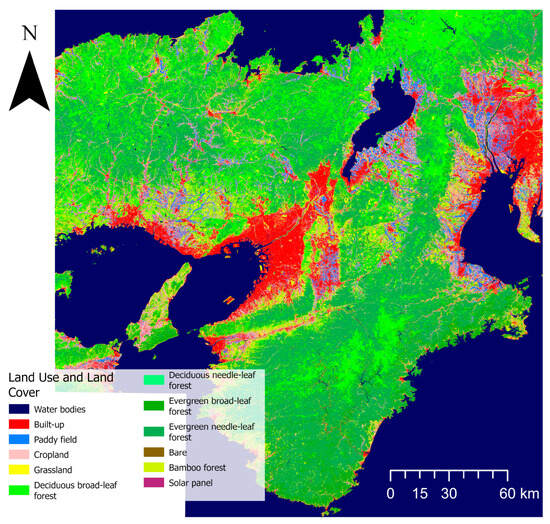
Figure 2.
Datasets of HRLULC in the Kansai region. (Source: mapped from [46]).
This study used the Agricultural Land Polygon Data and HRLULC to accurately estimate the distribution of reclaimable idle cropland in this study [47]. The former helps identify the distribution of agricultural land at the parcel level, while the latter excludes current agricultural land. Furthermore, in alignment with the MOE survey methods, a buffer zone of 5 m was established inward from the boundaries of each agricultural plot. In addition, based on the MOE survey, parcels smaller than 16 m2, after this exclusion, were also removed from the analysis (Figure 3). This lower area limit is based on a survey that found that one unit of a typical rattan-shelf type AVS trestle is 4 m square in Japan [29]. Spatial analysis was conducted using ArcGIS Pro 3.1.3 software (Esri: Redlands, CA, USA).
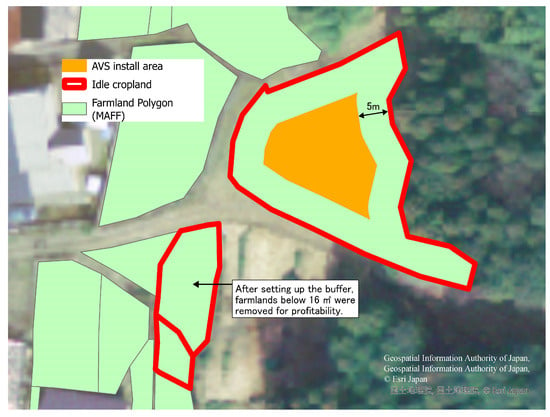
Figure 3.
Description of the Agricultural Land Polygon Data and AVS installation area.
2.5. Exclusion of High-Risk Areas
This study incorporates additional criteria for selecting installation areas to mitigate the high risks associated with sedimentation, flooding, and biodiversity conservation needs. Consequently, two distinct scenarios were developed: the Full-Coverage (FC) Scenario and the Priority-Coverage (PC) Scenario. The FC scenario expects to install AVSs on all detectable reclaimable idle cropland, as identified in Section 2.4 while excluding areas with disaster and environmental risks, as outlined in Table 3. Conversely, the PC scenario adopts a more profitable approach, focusing only on areas within the FC scenario that are more viable for power generation business operations. This scenario integrates additional financial risk factors into its exclusion criteria, as detailed in the lower section of Table 3.

Table 3.
High-risk areas were excluded from consideration in this study.
2.6. Evaluation of the Outputs
Upon identifying suitable reclaimable idle cropland, this study proceeded to estimate the electricity and crop yields achievable via the deployment of agricultural voltaic systems (AVS). Solar radiation and temperature data were sourced from the MONSOLA-20 database to calculate electricity generation. Managed by Japan’s New Energy and Industrial Technology Development Organization (NEDO) [32], MONSOLA-20 offers comprehensive datasets on solar radiation, temperature, snow occurrence, etc., derived from a combination of ground-based and satellite observations. These datasets cover the entirety of Japan with a mesh resolution of approximately 1 km, corresponding to the north–south (1/120) and east–west (1/80) degrees. Notably, the database includes information on the tilt angle that maximizes the annual cumulative solar radiation (the annual optimum tilt angle) and the associated slope solar radiation. This study assumed that PV panels would be installed at this annual optimum tilt angle for power generation calculations. The methodology follows the “Estimation method of generating electric energy by PV power systems” established by the Japanese Standards Association [49].
Soybean production agricultural yields were evaluated at 80% of the average per-area harvest in each prefecture based on conventional farming practices [50]. This 80% threshold aligns with the minimum yield criteria set by Japan’s AVS support program, representing a conservative approach [51,52]. Previous research supports this assumption, demonstrating that even with a solar transmittance of 73–75%, yields reaching 85–92% of control scenarios are achievable, validating the prudence of this assumption [53].
3. Results
3.1. Full-Coverage Scenario
Figure 4 and Figure 5 present the municipal-level outcomes. The highest annual electricity generation was identified in Koka City, Shiga Prefecture, where 199.7 GWh of electricity was supplied annually through AVSs installed on reclaimable idle cropland. Moreover, when examining the ratio of electricity generated to electricity consumed (referred to as the AVS electricity self-sufficiency rate), 53 municipalities were identified as capable of achieving a 15% AVS electricity self-sufficiency rate. This percentage aligns with the Japanese government’s proposed energy mix target for 2030, a range from 14% to 16% for solar power generation. Notably, in seven municipalities, the annual electricity generation from AVSs exceeded annual electricity consumption. Among these, Minamiyamashiro Village in Kyoto Prefecture exhibited the highest AVS electricity self-sufficiency rate of 393.4% out of the 227 municipalities assessed.
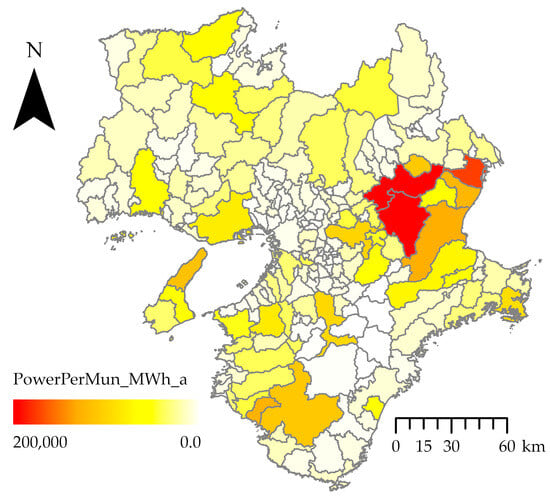
Figure 4.
Annual electricity generated by municipality in the full-coverage scenario (first year).
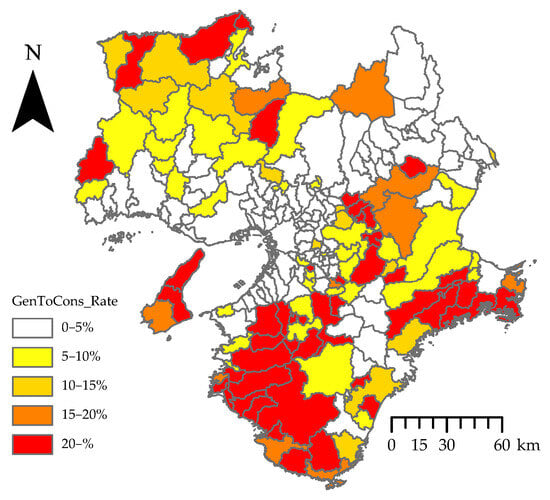
Figure 5.
Electricity rates generated compared with prefecture consumption by municipality in the full-coverage scenario.
Table 4 and Figure 6 and Figure 7 illustrate the results at the prefectural level. Mie Prefecture was the highest electricity generator in the first year, producing 1267.87 GWh, while Osaka Prefecture generated the least electricity in the Kansai region, with 322.23 GWh. Regarding the proportion of electricity covered by AVS, Wakayama Prefecture led with 12.7%, whereas Osaka Prefecture was at the lower end with 0.6%.

Table 4.
Results of the full-coverage scenario analysis.

Figure 6.
Annual electricity generated by prefecture in the full-coverage scenario (first year).
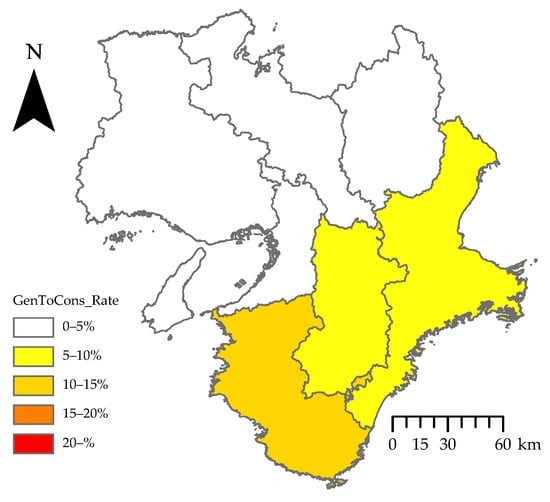
Figure 7.
Electricity rates generated compared with prefecture consumption in the full-coverage scenario.
3.2. Priority-Coverage Scenario
In the PC scenario, the assessment of potential is confined to the areas most suited for AVS installation, resulting in a reduced installation scale. This reduction is evident when comparing Figure 4 and Figure 5 with Figure 8 and Figure 9, with a noticeable overall decrease in the red areas, indicative of high potential zones. The highest annual power generation at the municipal level was observed in Yokkaichi City, Mie Prefecture, with the potential of AVS on reclaimable idle cropland suitable for power generation projects to supply approximately 95.1 GWh of electricity annually. Regarding AVS power self-sufficiency, the PC scenario identified five municipalities capable of achieving a 15% AVS electricity self-sufficiency rate, just under one-tenth the number found in the FC scenario. Unlike the FC scenario, where seven municipalities exceeded 100% in AVS electricity self-sufficiency, no municipalities that could achieve this benchmark were found in the PC scenario.
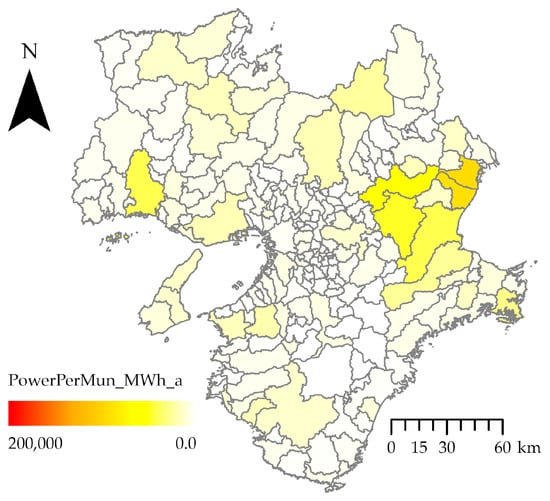
Figure 8.
Annual electricity generated by municipality in the priority-coverage scenario (first year).
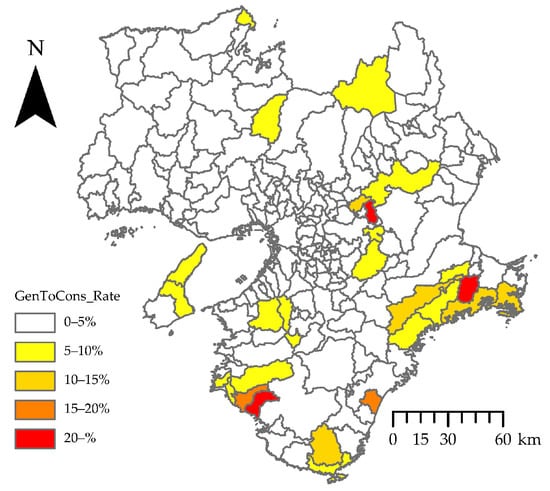
Figure 9.
Electricity rates generated compared with municipality consumption in the priority-coverage scenario.
Table 5 and Figure 10 and Figure 11 present these results, collated at the prefectural level. Following the exclusion of areas with slopes ranging from 10 to 20 degrees and those facing north, the identified reclaimable idle cropland for installation significantly diminished across the Kansai region. Mie Prefecture continued to have the largest area of reclaimable idle cropland at 12.81 km2, whereas Nara Prefecture had the smallest, with its area shrinking by 82% from 12.75 km2 in the FC scenario to merely 2.31 km2. In terms of electricity generation, the prefectural output in the PC scenario fell between 10% and 40% of that in the FC scenario. Nonetheless, Mie and Wakayama prefectures still demonstrated the potential to supply approximately 2% of their annual electricity consumption through solar power within the constraints of the PC scenario.

Table 5.
Results of the priority-coverage scenario analysis.
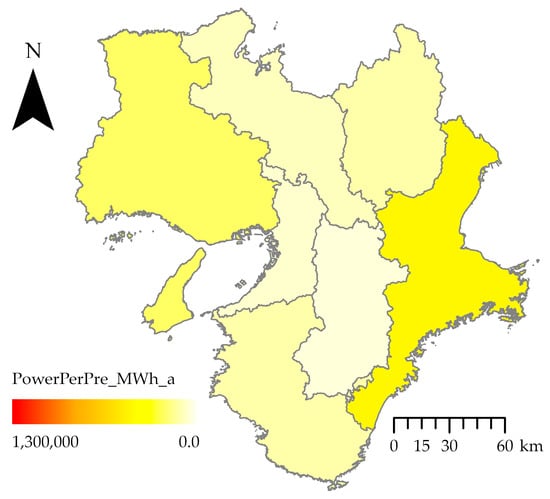
Figure 10.
Annual electricity generated by prefecture in the priority-coverage scenario (first year).

Figure 11.
Electricity rates generated compared with prefecture consumption in the priority-coverage scenario.
3.3. Comparison of Methods for Detecting Reclaimable Idle Cropland
The objective of this research is to develop a method with high precision for identifying reclaimable idle croplands. To evaluate the accuracy of this detection method, we conducted a comparative analysis between the extent of reclaimable idle croplands identified in each municipality through the FC scenario and that determined by the MOE survey methodology. The latter estimates reclaimable idle cropland area within each prefecture by apportioning it according to the expanse of arable land. The prefectural idle cropland data draws upon field investigations by the agricultural committees of respective municipalities, which have been criticized for inaccuracies in reporting idle cropland due to manpower shortages, among other factors [55]. In addition, it is important to acknowledge that this approach does not incorporate geographic information systems and fails to omit zones identified as high-risk, including disaster-stricken areas.
Figure 12 illustrates the disparity in the quantified reclaimable idle cropland area across municipalities, contrasting the results derived from the methodology of this study with those from the MOE’s survey methodology. The vertical axis represents the difference in reclaimable idle cropland area identified under the FC scenario from that calculated via the MOE’s method, while the horizontal axis showcases the reclaimable idle cropland area recognized under the FC scenario for each municipality, plotted on a logarithmic scale. This graphical representation reveals that the greater the area of reclaimable idle cropland detected in a municipality according to the FC scenario, the more substantial the deviation from the MOE’s survey results.
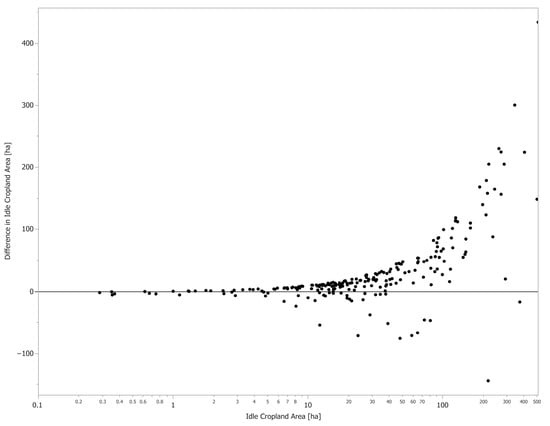
Figure 12.
Differences in areas of reclaimable idle croplands detected by the two methods.
4. Discussions
4.1. Detection of Reclaimable Idle Cropland
Within this research, we have developed a methodology utilizing Agricultural Land Polygon Data and the HRLULC database to pinpoint reclaimable idle croplands with precision. Employing this approach, we discerned 130.19 km2 (0.39% of the study area) under the FC scenario and 38.71 km2 (0.12% of the study area) under the PC scenario of reclaimable idle cropland in the Kansai region of Japan. A comparison of the detection methods used in this study with those employed in the MOE survey (refer to Figure 12) reveals that the methods of this study identified a larger area of reclaimable idle cropland than those utilized in the MOE survey. Moreover, in municipalities where this study’s detection method detected a larger area of reclaimable idle cropland, a notable difference was observed in the area of reclaimable idle cropland detected between the two methods. This divergence may primarily stem from the agricultural boards’ resource constraints in conducting comprehensive idle cropland assessments in alignment with MOE’s protocols. Specifically, municipalities with substantial idle croplands confront significant challenges, including insufficient workforce for thorough cropland evaluations, leading to substantial discrepancies between actual conditions and reported statistics. Leveraging geographic data derived from satellite imagery, our method has potentially uncovered reclaimable idle croplands previously unrecorded in surveys by the Board of Agriculture or MOE. Furthermore, with the precise distribution, location, and configuration of reclaimable idle croplands now elucidated, it facilitates the integration of this data with other geographic information, such as land use maps and sediment disaster alert areas, and to establish appropriate separation distances to minimize the impact on adjacent parcels.
4.2. Electricity Output
This study estimated the AVS installation potential with a focus on reclaimable idle cropland in the study area. This analysis was conducted in light of previous studies’ limitations in terms of accuracy and trade-offs between food and energy security. The results of the GIS validation showed that the capacity for augmenting open-field, fixed overhead AVS on reclaimable idle cropland within the study area, identifying potential capacities of 3962.24 MWac under the FC scenario and 1050.44 MWac under the PC scenario (Table 4 and Table 5). The Kansai Electric Power Co., Inc.(Osaka, Japan), a principal utility in the region’s energy supply network, has set a goal to add 5000 MW from renewable energy sources domestically by the year 2040 [56]. The projected scale of AVS deployment on reclaimable idle cropland, as indicated, represents 21–79% of this target, underscoring the substantial significance of the validation results.
As for electricity generated, through the installation of AVSs on reclaimable idle cropland, an additional 4564.08 GWh of electricity per year could be supplied under the FC scenario, while 1212.26 GWh of electricity per year could be supplied under the PC scenario (Table 4 and Table 5 and Figure 6 and Figure 10). The amount of electricity generated is equivalent to 3.1% and 0.8% of the annual electricity consumption of the study area (Table 4 and Table 5 and Figure 7 and Figure 11). Furthermore, regarding AVS electricity self-sufficiency, in the FC scenario, seven municipalities could supply more electricity than they consume annually through AVS installations on reclaimable idle cropland. Under the FC scenario, 53 of the 227 municipalities in the target region (about 23%) could achieve a 15% PV share in their energy mix through AVS (Figure 5). This means that the AVS potential is distributed over a wide geographic area, which is a policy selling point for improving energy and food security.
However, the results also underscored substantial regional variations in the AVS electricity self-sufficiency rates. In rural municipalities, the findings suggest that the contribution of AVS to decarbonization policies might be more substantial than previously believed. While this outcome aids in achieving carbon neutrality, the potential for loss of farmland due to pseudo-farming cannot be overlooked. Improving the AVS approval process by promptly establishing guidelines and zoning, both based on agroecology, in the concerned areas could effectively mitigate these risks and expedite the approval of exemplary AVS projects. Conversely, urban areas, notably Osaka, with limited agricultural land and higher electricity demands, had lower AVS electricity self-sufficiency rates. In Japan, the adoption of photovoltaic systems on the roofs and walls of residential and commercial buildings, in addition to agricultural land, has been identified as a solution to the shortage of suitable sites for ground-mounted photovoltaic systems [57]. In urban settings, where farmland is scarce, simultaneously considering AVS and deploying photovoltaic installations on buildings may offer effective energy solutions that adapt to the unique urban landscape.
4.3. Agriculture
The results of the GIS validation showed that through the installation of AVSs on reclaimable idle cropland, an additional 930.82 tons of soybeans per year could be supplied under the FC scenario, while 274.19 tons of soybeans per year could be supplied under the PC scenario (Table 4 and Table 5). This augmentation corresponds to 6.2% and 1.8% of the soybean harvest recorded in the study area for the year 2021, respectively, and would enhance the region’s self-sufficiency rate by 0.15 and 0.04 percentage points [35,36,37]. Although the uplift in self-sufficiency rates appears nominal, its implications for food security are significant, as the baseline self-sufficiency rate was notably low at 2.37%, and the activation of reclaimable idle cropland will expand the expanse of cultivable farmland.
4.4. Limitations and Future Prospects
Although not explored in depth in this study, a critical aspect of social implementation is the issue of diversity in agriculture and photovoltaic power generation systems. This study focuses on combining growing soybeans with conventional farming methods and rattan-shelf AVS. However, from an agroecological perspective, incorporating more complex farming systems, such as various mixtures, crop rotation, and crop–livestock integration, is warranted. In addition, a wide variety of options exist concerning power generation systems, including single/two-axis tracking systems, vertical bifacial setups, PV greenhouse systems, and spectrally selective photovoltaic modules. Because this study focused on scenarios using orthodox systems, these advanced systems have not been discussed. However, their integration could provide synergistic benefits within an agroecological framework. Furthermore, when establishing an AVS project, it is essential to consider the agricultural and social characteristics of the target area to optimize the system combination. Consequently, the subsequent phase of this research ought to entail an in-depth analysis that concentrates on these unique regional aspects and economic feasibility.
5. Conclusions
Japanese agriculture is currently confronted with the pressing challenges of advancing decarbonization efforts, revitalizing underutilized agricultural lands, and enhancing food security. In this context, the initiative to install AVSs on reclaimable idle croplands presents an effective solution that addresses these issues simultaneously. However, the potential of this initiative remained unclear because of the limitations of previous statistical and survey methods, which failed to accurately map the distribution of reclaimable idle croplands.
This research developed a highly precise method utilizing Agricultural Land Polygon Data and the HRLULC database to detect reclaimable idle croplands. Consequently, we unveiled the detailed distribution of reclaimable idle croplands, including precise locations and configurations previously undetected by previous survey methods. A quantitative assessment of the AVS output was conducted, focusing exclusively on low-risk reclaimable idle croplands within the Kansai region of Japan. The findings confirmed the potential annual production of 4564.08 GWh of electricity—accounting for 0.8% of the region’s yearly electricity consumption—and 930.82 tons of soybeans, equating to 6.2% of the area’s annual soybean yield. Furthermore, 5 of 227 municipalities were shown to be capable of achieving 15% electricity self-sufficiency through reclaimable idle cropland AVS alone, even under the PC scenario, which omits areas deemed low suitable for solar power generation. The realization of such outputs, despite stringent conditions, underscores the critical importance of revitalizing idle cropland and the value of utilizing AVS for policymakers in decarbonization and agriculture within each municipality. In particular, municipalities with high AVS electricity self-sufficiency rates, as identified in this study, may need to establish rules, such as screening guidelines, as soon as possible to promote the proper introduction of AVS. Future research should examine more innovative frame structures and farming practices, focusing on economic viability.
Author Contributions
Conceptualization, H.N.; Methodology, H.N.; Software, H.N.; Validation, H.N.; Formal analysis, H.N.; Investigation, H.N. and S.O.; Data curation, H.N.; Writing—original draft, H.N.; Writing—review and editing, S.O.; Visualization, H.N.; Supervision, S.O.; Project administration, H.N.; Funding acquisition, H.N. and S.O. All authors have read and agreed to the published version of the manuscript.
Funding
This research was funded by the JST SPRING Grant Number JPMJSP2110, MEXT/JSPS KAKENHI Grant Number 19K12444, SPIRITS 2022 of Kyoto University, and Sompo Environment Foundation.
Data Availability Statement
The data presented in this study are available upon request from the corresponding author.
Acknowledgments
The authors are grateful to the reviewers and editor for their helpful comments to improve the paper.
Conflicts of Interest
The authors declare no conflicts of interest.
References
- International Atomic Energy Agency. Available online: https://www.iaea.org/topics/greenhouse-gas-reduction (accessed on 24 August 2023).
- MAFF. Available online: https://www.maff.go.jp/e/policies/env/env_policy/meadri.html (accessed on 12 October 2023).
- Agency for Natural Resources and Energy. Available online: https://www.enecho.meti.go.jp/category/others/basic_plan/pdf/20211022_01.pdf (accessed on 3 April 2023).
- Agency for Natural Resources and Energy. Available online: https://www.enecho.meti.go.jp/statistics/total_energy/pdf/honbun2021fykaku.pdf (accessed on 19 January 2024).
- Ministry of Justice. Available online: https://www.japaneselawtranslation.go.jp/en/laws/view/3174 (accessed on 19 January 2024).
- MAFF. Available online: https://www.maff.go.jp/j/nousin/tikei/houkiti/attach/pdf/index-16.pdf (accessed on 1 October 2023).
- MAFF. Available online: https://www.maff.go.jp/j/zyukyu/fbs/attach/pdf/index-20.pdf (accessed on 2 October 2023).
- MOE. Available online: https://www.biodic.go.jp/biodiversity/activity/policy/jbo3/generaloutline/files/JBO3_pamph_en.pdf (accessed on 9 October 2023).
- Sasaki, K.; Hotes, S.; Ichinose, T.; Doko, T.; Wolters, V. Hotspots of Agricultural Ecosystem Services and Farmland Biodiversity Overlap with Areas at Risk of Land Abandonment in Japan. Land 2021, 10, 1031. [Google Scholar] [CrossRef]
- Iida, Y.; Sawada, S.; Hirata, S.; Furuya, M.; Yamaguti, Y.; Yamabata, N.; Yayota, C. Available online: https://www.maff.go.jp/j/seisan/tyozyu/higai/manyuaru/attach/pdf/manual-14.pdf (accessed on 7 October 2023).
- MAFF. Available online: https://www.maff.go.jp/j/nousin/noukei/totiriyo/attach/pdf/nouchi_tenyo-1.pdf (accessed on 19 January 2024).
- MAFF. Available online: https://www.maff.go.jp/j/nousin/noukei/totiriyo/attach/pdf/einogata-7.pdf (accessed on 19 January 2024).
- Fujiwara, C.; Takeyama, E. Factors Hindering the Operation of the Non-farmland Notification System in Area of Agricultural Land: From the results of a survey of all 20 municipalities in Ehime Prefecture. Trans. Jpn. Soc. Irrig. Drain. Rural Engin. 2022, 90, I_299–I_308. [Google Scholar] [CrossRef]
- Wezel, A.; Herren, B.G.; Kerr, R.B.; Barrios, E.; Gonçalves, A.L.R.; Sinclair, F. Agroecological Principles and Elements and Their Implications for Transitioning to Sustainable Food Systems. A Review. Agron. Sustain. Dev. 2020, 40, 40. [Google Scholar] [CrossRef]
- Marrou, H.; Dufour, L.; Wery, J. How Does a Shelter of Solar Panels Influence Water Flows in a Soil–crop System? Eur. J. Agron. 2013, 50, 38–51. [Google Scholar] [CrossRef]
- Goetzberger, A.; Zastrow, A. On the Coexistence of Solar-Energy Conversion and Plant Cultivation. Int. J. Sol. Energy 1982, 1, 55–69. [Google Scholar] [CrossRef]
- MAFF. Available online: https://www.maff.go.jp/j/nousin/noukei/totiriyo/attach/pdf/einogata-9.pdf (accessed on 9 November 2023).
- MAFF. Available online: https://www.maff.go.jp/j/study/attach/pdf/nouti_housei-27.pdf (accessed on 12 May 2023).
- Nakata, H.; Ogata, S. Regional Economic Cycle Through the Use of AgriVoltaics on Abandoned Lands-Case of Kyoto Prefecture. In Proceedings of the AgriVoltaics Conference, Piacenza, Italy, 15–17 July 2022; TIB Open Publishing: Hannover, Germany, 2022; pp. 1–8. [Google Scholar]
- Sacchelli, S.; Garegnani, G.; Geri, F.; Grilli, G.; Paletto, A.; Zambelli, P.; Ciolli, M.; Vettorato, D. Trade-off between Photovoltaic Systems Installation and Agricultural Practices on Arable Lands: An Environmental and Socio-Economic Impact Analysis for Italy. Land Use Policy 2016, 56, 90–99. [Google Scholar] [CrossRef]
- Katkar, V.V.; Sward, J.A.; Worsley, A.; Zhang, K.M. Strategic Land Use Analysis for Solar Energy Development in New York State. Renew. Energy 2021, 173, 861–875. [Google Scholar] [CrossRef]
- Takashima, T.; Nakashima, A.; Yuzaki, M. Research into Possibility of the Introduction of Solar Photovoltaic Generation and Wind Power Generation in Abandoned Farmland in Wakayama Pref. J. Environ. Inf. Sci. 2014, 28, 167–172. [Google Scholar] [CrossRef]
- Shimazaki, Y. Agrivoltaic Potential of Abandoned Farmlands in the National Capital Region of Japan. J. Jpn. Soc. Energy Resour. 2021, 42, 93–97. [Google Scholar] [CrossRef]
- Muroki, S.; Nakatani, J.; Kurisu, K.; Moriguchi, Y.; Hanaki, K. Evaluation of the Installation Potential of Agrivoltaic System in Consideration of Limiting Factors—A Case Study in Kanto Region. J. Jpn Soc. Civ. Eng. G. 2018, 74, II_221–II_228. [Google Scholar] [CrossRef]
- Yamada, A.; Ogata, S. Potential Evaluation of Agrivoltaic Case of Kyoto Prefecture Japan. AIP Conf. Proc. 2021, 2361, 020003. [Google Scholar] [CrossRef]
- Nakata, H.; Ogata, S. Integrating Agrivoltaic Systems into Local Industries: A Case Study and Economic Analysis of Rural Japan. Agronomy 2023, 13, 513. [Google Scholar] [CrossRef]
- Sato, H.; Mitra, B.K.; Dasgupta, R.; Hashimoto, S. Assessment of Alternative Land Resource Utilisation towards Net-Zero and Regional Revitalisation through the Circulating and Ecological Sphere in Depopulated City Regions in Japan: A Case Study of Hachinohe City Region. Sustain. Sci. 2023, 18, 2151–2168. [Google Scholar] [CrossRef]
- MAFF. Available online: https://www.maff.go.jp/j/tokei/census/afc/2020/030628.html (accessed on 20 October 2023).
- MOE. Available online: https://www.renewable-energy-potential.env.go.jp/RenewableEnergy/index.html (accessed on 18 May 2023).
- MIC. Available online: https://www.stat.go.jp/data/kokusei/2020/kekka.html (accessed on 6 July 2023).
- Kansai Bureau of Economy, Trade and Industry. Available online: https://www.kansai.meti.go.jp/E_Kansai/page/20230105/02.html (accessed on 24 August 2023).
- NEDO; Japan Weather Association. Available online: https://appww2.infoc.nedo.go.jp/appww/monsola_map.html (accessed on 3 July 2023).
- Scognamiglio, A. “Photovoltaic Landscapes”: Design and Assessment. A Critical Review for a New Transdisciplinary Design Vision. Renew. Sustain. Energy Rev. 2016, 55, 629–661. [Google Scholar] [CrossRef]
- NEDO. Available online: https://www.nedo.go.jp/content/100960315.pdf (accessed on 21 November 2023).
- MAFF. Available online: https://www.e-stat.go.jp/stat-search/files?lid=000001406582 (accessed on 19 January 2024).
- Statistics Bureau of Japan. Available online: https://www.stat.go.jp/data/jinsui/2022np/index.html (accessed on 19 January 2024).
- MAFF. Available online: https://www.maff.go.jp/j/tokei/kouhyou/sakumotu/sakkyou_kome/index.html (accessed on 19 January 2024).
- MAFF. Available online: https://www.maff.go.jp/j/seisan/ryutu/daizu/attach/pdf/index-3.pdf (accessed on 19 January 2024).
- Chiba Prefectural Government. Available online: https://www.pref.chiba.lg.jp/noushin/documents/taisaku-manual-rvsd3.pdf (accessed on 18 July 2023).
- MAFF. Available online: https://www.maff.go.jp/j/nousin/tikei/houkiti/attach/pdf/index-10.pdf (accessed on 10 November 2023).
- MAFF. Available online: https://www.maff.go.jp/j/nousin/tikei/houkiti/attach/pdf/index-9.pdf (accessed on 28 August 2023).
- MAFF. Available online: https://map.maff.go.jp/ (accessed on 28 August 2023).
- Board of Audit of Japan. Available online: https://www.jbaudit.go.jp/pr/kensa/result/3/r031022_1.html (accessed on 23 October 2023).
- MAFF. Available online: https://www.maff.go.jp/j/tokei/porigon/ (accessed on 13 February 2023).
- MLIT. Available online: https://nlftp.mlit.go.jp/ (accessed on 3 July 2023).
- JAXA. Available online: https://www.eorc.jaxa.jp/ALOS/en/dataset/lulc/lulc_v2111_e.htm (accessed on 18 August 2023).
- Nakata, H.; Ogata, S. Study on the Feasibility of Agrivoltaics in the Kansai Region of Japan. Biol. Life Sci. Forum 2023, 27, 11. [Google Scholar] [CrossRef]
- Geospatial Information Authority of Japan. Available online: https://fgd.gsi.go.jp/download/menu.php (accessed on 3 July 2023).
- JIS C 8907:2005; Estimation Method of Generating Electric Energy by PV Power System. Japanese Standards Association: Tokyo, Japan, 2005.
- MAFF. Available online: https://www.e-stat.go.jp/stat-search/files?stat_infid=000040068742 (accessed on 23 August 2023).
- MAFF. Available online: https://www.maff.go.jp/j/nousin/noukei/totiriyo/attach/pdf/einogata-1.pdf (accessed on 11 September 2023).
- MAFF. Available online: https://www.maff.go.jp/j/nousin/noukei/totiriyo/attach/pdf/einogata-43.pdf (accessed on 11 September 2021).
- Fujita, Y.; Nagumo, Y.; Higuchi, Y.; Kawakami, O.; Yamada, N. Influence of Shading Treatment on Growth and Yield of Paddy Rice and Soybean with the Objective of Solar Sharing. Hokuriku Crop Sci. 2019, 54, 22–27. [Google Scholar] [CrossRef]
- MOE. Available online: https://www.env.go.jp/policy/local_keikaku/tools/karte.html (accessed on 18 June 2023).
- Ministry of Internal Affairs and Communications. Available online: https://www.soumu.go.jp/main_content/000388143.pdf (accessed on 19 January 2024).
- The Kansai Electric Power Group Company, Incorporated. Available online: https://www.kepco.co.jp/english/corporate/list/report/pdf/zc_roadmap2022.pdf (accessed on 19 January 2024).
- NEDO. Available online: https://www.nedo.go.jp/content/100926249.pdf (accessed on 19 January 2024).
Disclaimer/Publisher’s Note: The statements, opinions and data contained in all publications are solely those of the individual author(s) and contributor(s) and not of MDPI and/or the editor(s). MDPI and/or the editor(s) disclaim responsibility for any injury to people or property resulting from any ideas, methods, instructions or products referred to in the content. |
© 2024 by the authors. Licensee MDPI, Basel, Switzerland. This article is an open access article distributed under the terms and conditions of the Creative Commons Attribution (CC BY) license (https://creativecommons.org/licenses/by/4.0/).